Gigabyte P34W v3 Gaming Laptop Review
Gigabyte's P34W v3 is one of the only two 14-inch gaming notebooks with GeForce GTX 970M graphics. Can portability and performance really coexist?
Why you can trust Tom's Hardware
Gaming Benchmark Results
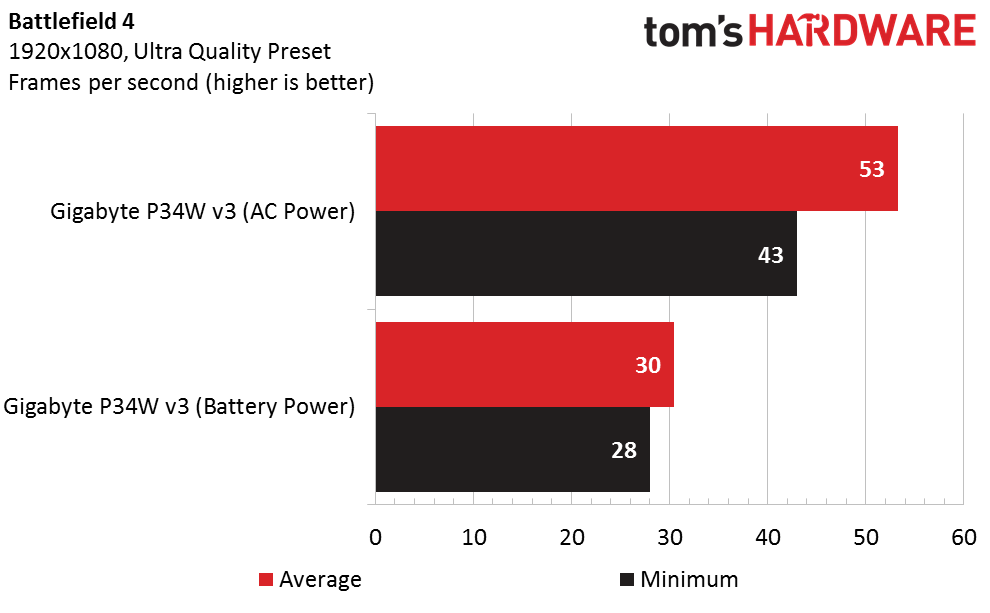
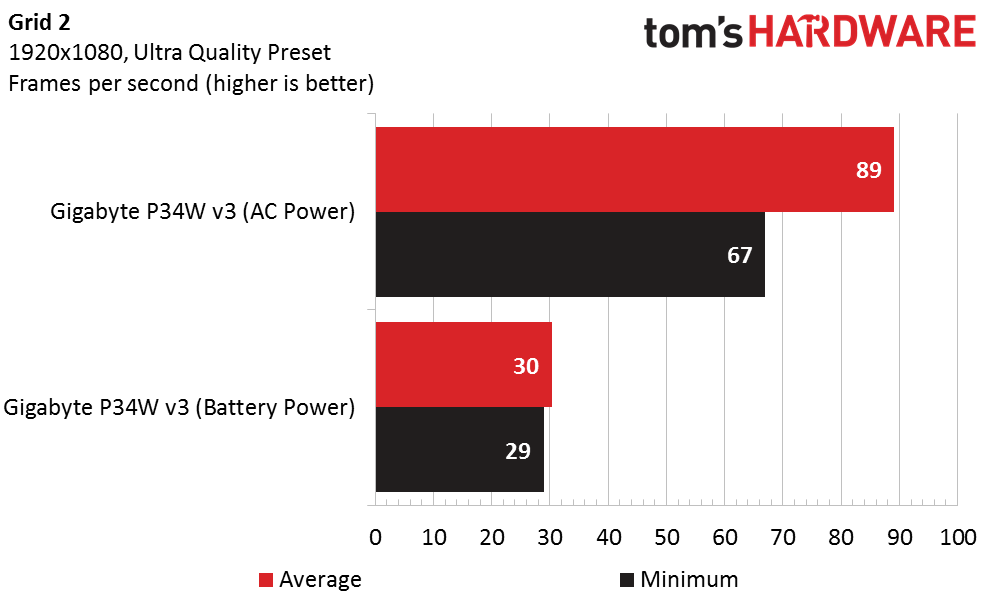
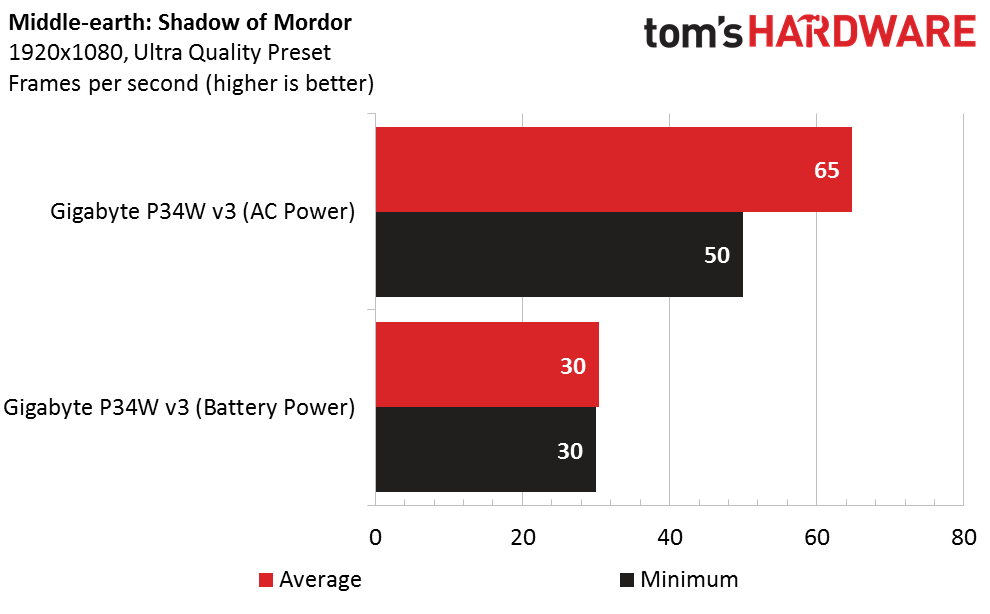
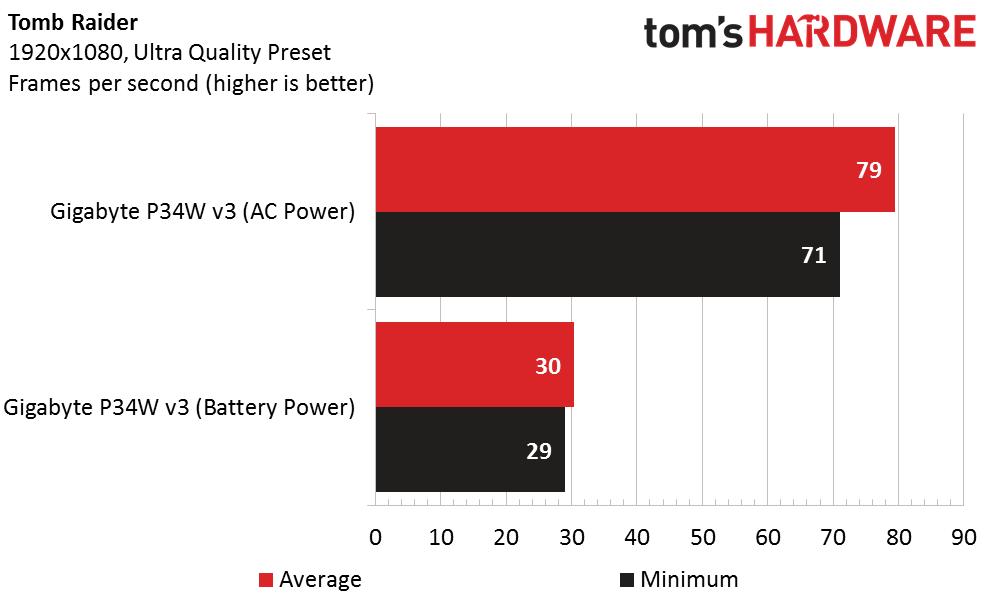
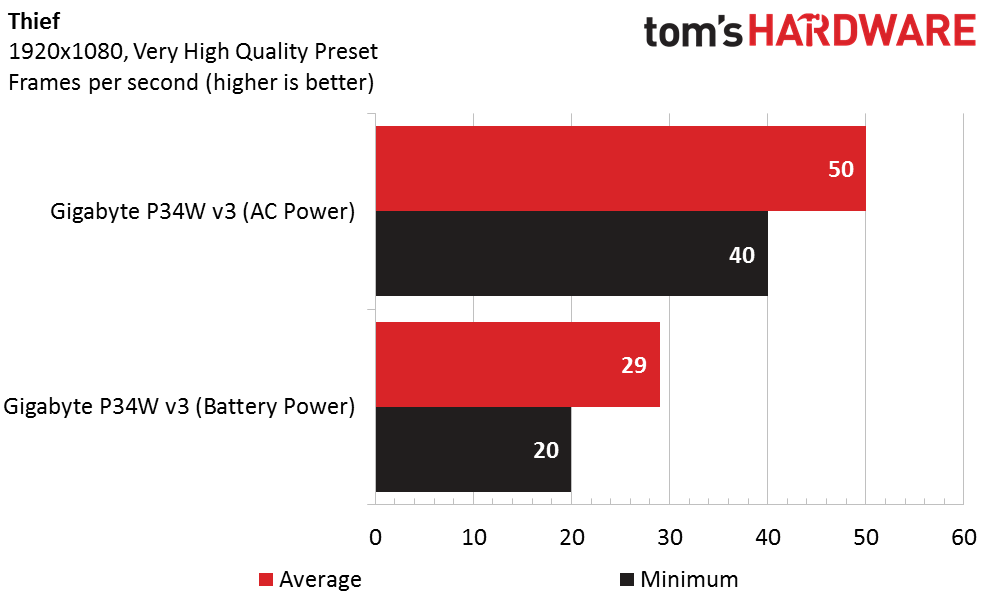
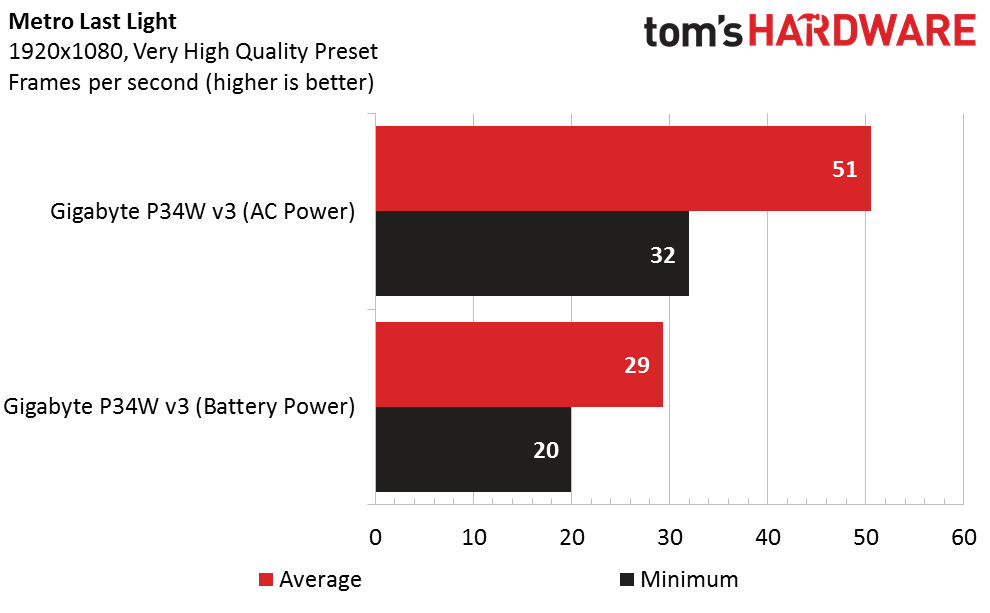
We run our game tests plugged in and away from the wall, yielding two very different looks at performance as Nvidia’s Battery Boost technology kicks in.
Ideally, we want to see the P34W v3 hold a steady 30 FPS on battery power (or whatever frame rate you specify through GeForce Experience). Then, when we attach the AC adapter, the notebook should generate playable performance at its panel’s native resolution and the highest-quality detail settings.
Gigabyte does not disappoint. Plugged in to the wall, we were able to crank each game up to 1920x1080 and its top graphics preset and enjoy smooth frame rates. Battlefield 4 averaged more than 53 FPS; Metro Last Light averaged 50; Tomb Raider nearly hit 80 FPS; Thief was up around 50 as well. The more platform-bound Grid 2 soared up to approach 90 FPS on average.
Even on battery power (and reduced clock rates) the P34W v3 is fast enough to maintain a smooth 30 FPS in these titles without giving up any graphics quality. For the system’s 14” FHD panel, a GeForce GTX 970M is just about right. Faster graphics modules (like the 980M) would really only be useful for attaching external displays. Then again, without a DisplayPort output, the P34W v3 wouldn’t be our top choice for docking to a more stationary desktop.
Get Tom's Hardware's best news and in-depth reviews, straight to your inbox.
Current page: Gaming Benchmark Results
Prev Page Synthetic Benchmark Results Next Page Productivity Benchmark Results-
Solandri I have this laptop. I'm not sure what brightness setting is 200 nits, but I find 50% good for daytime indoors, and 30% comfortable at night. I only feel the need to crank it above 50% if I'm by a sunny window. At 30% I get over 4 hours of battery life running office tasks and web browsing. Turning off hyperthreading in the BIOS extends that to almost 5 hours.Reply
The thermal throttling is a problem. But other owners have reported eliminating it by repasting and undervolting the CPU. I'm planning to do that, but haven't yet had time.
The VGA port is there because Gigabyte knows their market. Real gamers don't mind buying a big and heavy gaming laptop. These thin and light gaming laptops are mostly being bought by business people, who use it as their work laptop when they travel, then relax with some gaming in their hotel room. The lid is very nondescript - completely black with only the Gigabyte logo. Anyone looking at it would never guess it's a gaming laptop. Anyway, the VGA port is there so these business people can plug it into older projectors that are ubiquitous in meeting rooms. The laptop also has a HDMI port (and can output to both + screen simultaneously), though I would've preferred Displayport.
The fan noise can be obnoxious, but Gigabyte has included an app to let you quickly select fan and performance profiles. At the lowest setting ("stealth") the fan noise is completely acceptable in an office environment. Probably too much for a library when gaming. Performance takes a big hit, but it's more than adequate for most of the games I play. If you plan to use the other settings (low, high, max), break out the headphones.
Others have complained of problems with fit and finish. Some pieces of plastic aren't completely straight, or have gaps. Backlight bleed seems to be a common problem too. I'm fortunate in that mine doesn't have any backlight bleed or problems with fit and finish. I would buy it again in a heartbeat. -
mapesdhs Just wondering, when the GPU has pulled itself back to 848, is it still quicker than a 960M? If not, maybe Gigabyte would have been better off making this 960M-based, though if the mobile versions differ in the way the desktop cards do, perhaps even a reduced 970M is still way quicker than a 960M.Reply
Don't laptops at least have the option of running on full power from the battery, instead of always reducing the clocks, etc.? One should at least have the option of staying a max speed even on batter power, kinda handy if one knows the game time is only going to be 30 mins anyway, short train journey or something.
Ian.
-
rohitbaran @soldier44Reply
Well, as said in the review, there are not any laptops with that form factor and capability of 1440p gaming since it is really tough to get suitable performance from a card that can suitably fit in that form factor without burning itself out. So what do you expect? Unless you prefer jet engines for cooling fans... -
10tacle Reply16140667 said:@soldier44
Well, as said in the review, there are not any laptops with that form factor and capability of 1440p gaming since it is really tough to get suitable performance from a card that can suitably fit in that form factor without burning itself out. So what do you expect? Unless you prefer jet engines for cooling fans...
Thank you. Not to mention that generally mobile GPUs have to run at lower clock settings, have cut down shader and texture units, have less memory, and have a cut memory bus all to help keep not only the temps down but the power use down as well. A quick comparison link to a 970M vs. 970:
http://www.tomshardware.com/news/nvidia-geforce-maxwell-mobile-gtx-970m-gtx-980m,27833.html
But with that said, these days I find it hard to justify spending big bucks on a mobile PC gaming solution. I first and last spent nearly $2k on a high end Dell Alienware gaming laptop about 7 years ago (with a 1920x1200 17" display) and will never do it again. No way to upgrade and every new game out continued to need to be detuned in quality. Due to that, portable gaming for me eventually got transferred to the PS3 and more recently the PS4.
-
TallestJon96 It would be nice to get the 970m as a desktop card (960 ti). It's seems nearly perfect for 1080pReply -
Traciatim ReplyIt would be nice to get the 970m as a desktop card (960 ti). It's seems nearly perfect for 1080p
The 970m already has desktop equivalents in the 660ti and 760. The desktop 960 already outmatches the 970m by a good amount, the other way you can get a 750ti for cheap 1080p gaming with a good amount of settings turned up.
There are no desktop 900 series cards yet as slow as the 970m.
-
fimbulvinter ReplyThe VGA port is there because Gigabyte knows their market. Real gamers don't mind buying a big and heavy gaming laptop. These thin and light gaming laptops are mostly being bought by business people, who use it as their work laptop when they travel, then relax with some gaming in their hotel room. The lid is very nondescript - completely black with only the Gigabyte logo. Anyone looking at it would never guess it's a gaming laptop.
I have an older version of this model. Exact same chassis but previous model CPU and GPU.
But what you said is why I got it. This is a 70% work 30% gaming system for me and I honestly don't think there is too many other gaming laptops out there that don't scream GAMING LAPTOP with garish case lights and logos.
Although the thing really does scream GAMING LAPTOP when those fans spin up lol
-
Manticorp I have this laptop - I chose it over the Razer Blade because it was ~£600 cheaper AND I wanted the 1080p display over the 1800p display, and over the MSI ghost pro because I wanted something 14 inch and a bit more inconspicuous - and I have to say, it suits me down to the ground.Reply
Regarding gaming, it's been able to handle everything I throw at it enormously well. I play Far Cry 4 on a 3K Dell U2515H at max settings and it handles it fine, not an ounce of stutter.
I also use it at work every day, the battery lasts a good 4-5 hours for normal chores, and it's so unassuming and professional looking that I don't feel conspicuous using it. I have to plug it in if I'm out and about and want to watch a movie, as it'll only go about 1.5-2 hours then.
But then I go home, plug it into a nice big screen, and that's when the real playtime starts.
I found the Gigabyte P34W to be the only laptop to offer sleek, inconspicuous looks with extremely good gaming power underneath in a relatively affordable package.
I have a colleague who bought a Acer V Nitro - I'm so glad the Gigabyte has white backlit keys instead of RED (urgh).
I absolutely haven't looked back since buying this laptop - it's simply the best on the market if you want to use it for gaming and for work.
